Original URL: https://www.theregister.com/2013/04/19/review_netatmo_urban_weather_station/
Review: NetAtmo Urban Weather Station
The new obsession you've been waiting for
Posted in Personal Tech, 19th April 2013 09:29 GMT
Do we need a new obsession? Isn’t Facebook and Twitter enough for most folk? Some argue the British are obsessed about the weather.
It’s hardly surprising we talk about it all the time, the weather here changes so much, it never fails to be topical. Well that’s how it used to be. Lately, Blighty has been blighted by a godawful climate that hasn’t seen 20°C in six months yet last weekend finally broke the spell.
The witch is dead, apparently. So when it comes to our national obsession, NetAtmo’s Urban Weather Station is surely a tonic to this topic of conversation. Two cylindrical sensors take environmental measurements and using Wi-Fi send them to your phone, tablet or computer.
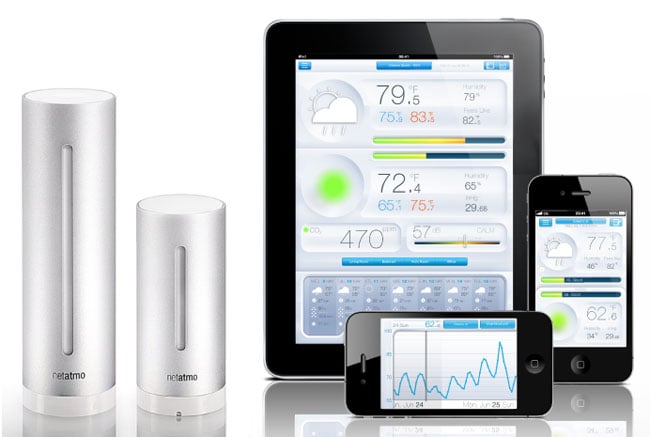
"Everywhere you go, you always take the weather with you"
When NetAtmo’s UWS was first announced it was originally iOS-only, but now it supports Android too and if you log-in from a computer, the web site has had a complete makeover recently which is very snappily laid out.
First things first though, you need to instal the NetAtmo desktop app and attach the indoor module to the computer using USB to get the UWS modules linked up to Wi-Fi. Alternatively, you can perform this procedure by linking up your iOS device directly to the main UWS from its USB port with a suitable iOS docking cable. There doesn’t appear to be a similar approach for Android though.
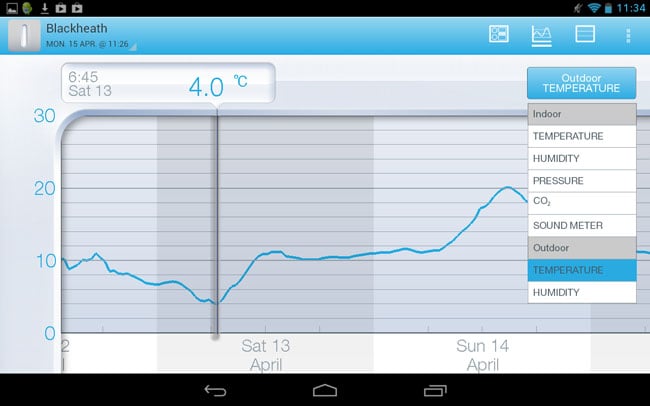
Android app graph choices
The Wi-Fi set-up also involves creating a user account but it’s a fairly straightforward process overall, just don’t be surprised if the installation is momentarily delayed by an automatic firmware update. You’ll also need to have the smaller outdoor unit ready powered up the four AAA batteries supplied in the box. With Wi-Fi established you can then hook up the indoor module to its PSU and position it somewhere suitable. The very basic set-up booklet gives cartoon guidance on where to place the units and, as far as more detailed instruction goes, simply points you to various links which include a full PDF manual.
In the box there are straps and screws for attaching the outdoor unit but as it can’t be fully exposed to the elements. It needs sheltering as you’re not supposed to get it wet, so choose your spot carefully. I put mine under a stone garden bench which was OK to start with, but eventually fell foul of the elements. NetAtmo uses MeteoGroup for its forecast data and the wind speed seems way too high most of the time, somebody should tell them. Incidentally, you can change the units of measurement for the sensors to suit your windspeed, temperature and pressure preferences.
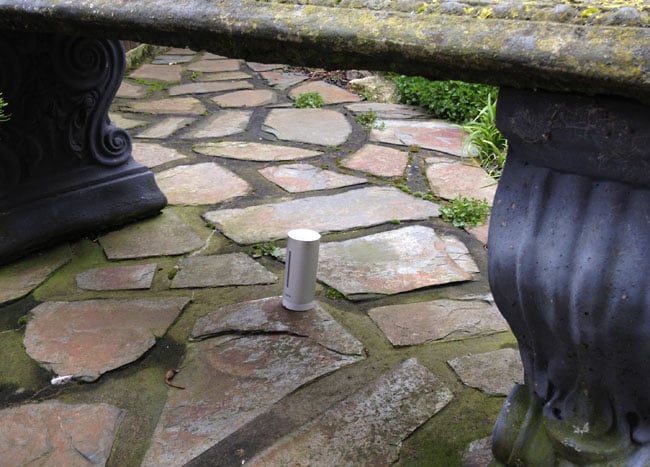
The outdoor module needs protection from the rain or the hygrometer gets stuck
One thing that isn’t exactly clear is how far apart these devices can be. The company claims 100m, but that's a relatively unobstructed maximum distance. Information on signal strength and battery level is displayed on the desktop app, which could help with tests and troubleshooting. Indeed, trying a fairly unobstructed line of sight position from 40ft away, the outdoor module in my greenhouse only dropped a couple of bars. To paraphrase the old saying, your footage may vary. Regarding wireless limits, I did wonder if the company would eventually bring out standalone satellite models that could record data to a micro USB card for retrieval later.
When it comes to measurements, the indoor module has a more comprehensive roster that can plot temperature, humidity, pressure, CO2 and sound levels. By contrast, the outdoor unit tracks only temperature and humidity, however, air quality and pollutant information appears but this is sourced from a location aware web site. The levels shown are based on the Citeair index which measures the overall air quality and the UWS app shows only the types that predominate, rather than all the measurable pollutants.
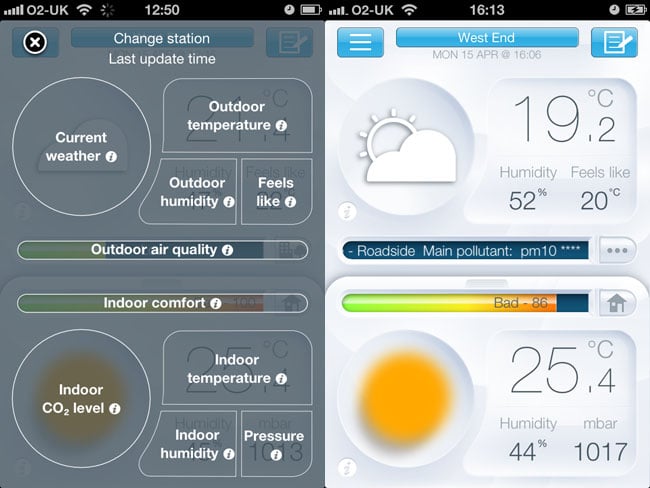
Tapping the info sections provide comprehensive descriptions of functions of the iPhone dashboard
NetAtmo claims the modules are accurate to ±0.3˚C, ±1mBar, ±3 per cent humidity and ±50ppm CO2. It relies 802.11b/g/n Wi-Fi with 915MHz or 868MHz communication between modules. If you don't have access to the mobile or desktop apps, simply touching the top of the indoor unit gives a colour coded assessment of the CO2. Green is good, yellow is a bit stuffy and red is definitely time to take some air.
In use at home it regularly reported ozone (O3) with NO2 and PM10 particulates appearing a couple of times although the latter would be a generalisation. Things became more animated when testing in the London's West End, the outdoor air quality indicator started scrolling information on the two main pollutants it reported. The in-app help provides useful information on all its measurements, so if you see something alarming, you can find out all about it.
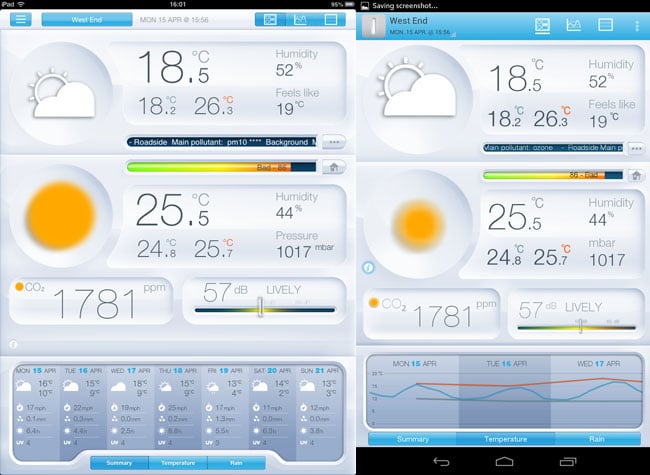
iPad 10in and Android 7in main dashboards
Personally, it was the pollutant measurements that I found the most fascinating and it was disappointing that the device wasn't detecting this itself and that there was no charting of this information either, which is a missed opportunity in my view. After all, if NetAtmo wants you to get obsessive about this stuff then this must be the way forward. We know what the weather is like by stepping outside, but the invisible stuff it detects should be given more prominence. Indeed, locally discovering an unusual peak in SO2 at specific times of the day could be a useful way of tracking down a serious problem.
Monitoring the environment
The interior module does detect and plot one gas that could well become an issue: CO2. Again, the app information gives you guidance on typical levels. In my kitchen it was rarely above 500ppm but get the gas cooker fired up and it would easily double that in a trice. So now my new obsession was ventilation but as I noticed there wasn’t much significant change during the week, another obsession took hold: the sound meter.
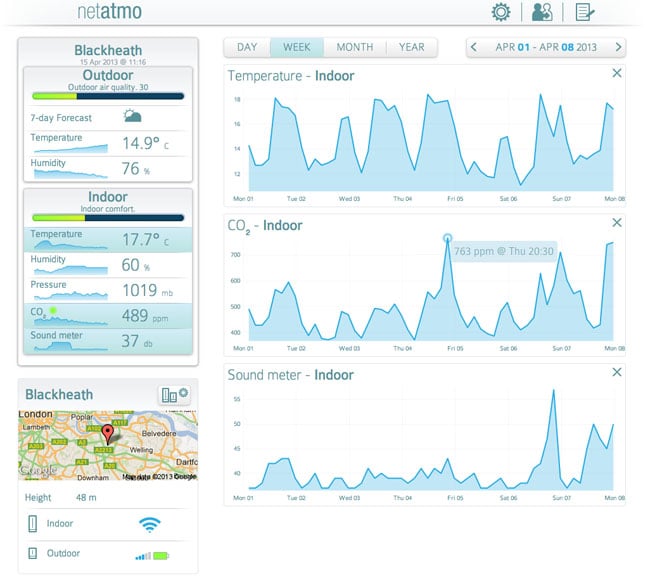
NetAtmo's revamped web interface also gives signal strength and battery condition info
You can set the Urban Weather Station modules to report extremes – for instance, when the temperature drops close to freezing or if an environment becomes too loud. So I configured the UWS to peaks in sound level but at a fairly low threshold. I was curious to discover any noises going on in my house during my absence – breaking and entering, exploding boiler, that sort of thing. Interestingly, when my nearest and dearest came and went during the day, it did clock up noise alerts. She thought it was a bit creepy – some kind of inverted stalking, but hey, I do live there.
And so there I am, sat on the train every morning, fidgeting with my phone and not really thinking about what app I'm going to fire up. I know I'll find something to amuse myself and, sure enough, I end up looking at the NetAtmo dashboard and discovering how cold it was outside last night. Colder than the night before. Not as humid mind, but then again the high pressure might have had something to do with it.
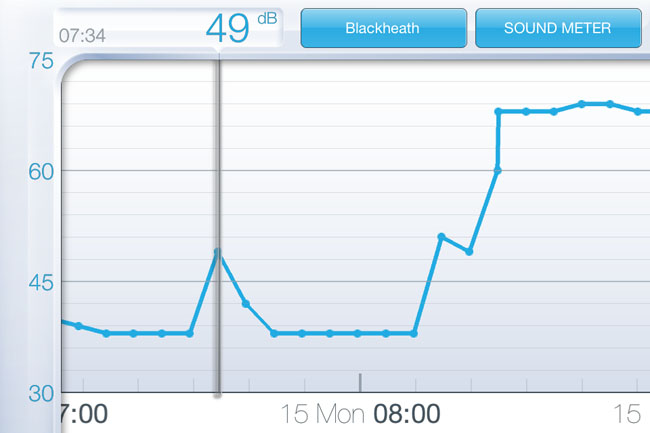
Sound meter chart: kettle on at 7.30am followed by general rummaging and the noise of the iRobot Scooba cleaning the kitchen floor
Rotating the phone to landscape view brings up the graphs – you make your choice from a drop down menu – and then pinch zoom to stretch out for blow by blow measurements roughly five minutes apart, spread across an hour or squeeze it all up to see weeks condensed into a chart showing two lines plotting the highs and lows.
Ah, that long unmoving humidity line at 90 per cent, that's when the outdoor module got soaked, you can see the temperature spike when I dried it out on the radiator and it started behaving again. This morning I mused over the temperature crossing the 20˚C barrier at the weekend. Man, that was a long time coming.
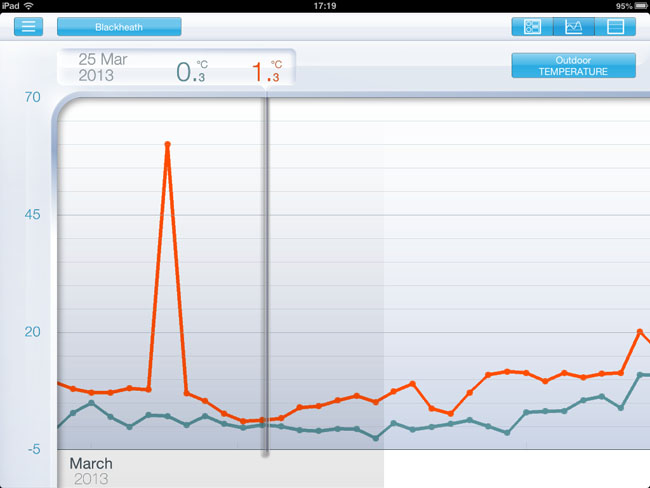
Outdoor temperatures between March and April – note the spike when drying out the wet unit
So what's wrong with this picture? Surely, as a Brit, it's normal to talk about the weather? Yes, but I'm having this conversation about the weather with myself. I'm not sure if that's playing the game. Audio features aside, her indoors (and outdoors) doesn't share my enthusiasm for the NetAtmo but beyond idle curiosity, it could be very useful in some areas if it remains within range. Have you valuables in the attic, a server in the shed or some hydroponic hedonism in the basement? Plumb in a NetAtmo Urban Weather Station and you can stay informed of any worrisome changes in those environments. At £139 though, it's a bit of an indulgence to keep you amused on the train. But then again, if you did manage to persuade an insurer to lower a premium based on this monitoring, then it could pay its way.
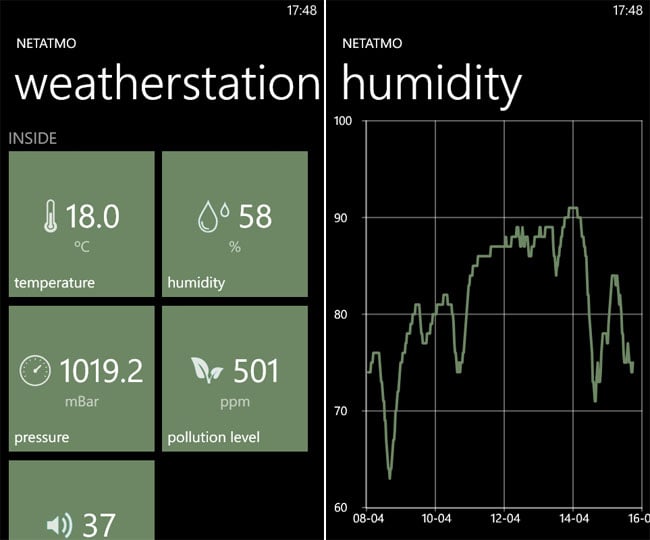
Windows Phone app
Furthermore, NetAtmo provides the means for its sensors to be used with other applications and you can export all or select data as either an XLS or CSV file. There are various apps and widgets out there to hook up with the NetAtmo with varied success. Admittedly, I gave up on Potsky's fragmented PHP widget and I don't know enough French to wade through the interfacing options at Box Domotique although it looks pretty neat. The OABsoftware's Windows Phone app is somewhat deceptive as it reports the CO2 as Pollution, and there I was thinking it would show more detail on those particulates. One obvious bug is that I couldn't switch between my Blackheath and West End NetAtmo weather stations, it defaulted to Blackheath.
The Reg Verdict
My initial impression of NetAtmo Urban Weather Station was it was another iOS/Android novelty device, which it does rather amount to in a domestic setting. Having to shelter the outdoor unit is a bit of a drawback too, but there are simple enough workarounds. Still, if you have sensitive environments to monitor or just workplace health concerns – from heat and humidity to noise and noxious gases – then these measurements provide reliable, accurate and easily accessible data on those conditions, within the limits of the available Wi-Fi. Yet given the £139 price tag, you either desperately need this information or you desperately need a new obsession. ®